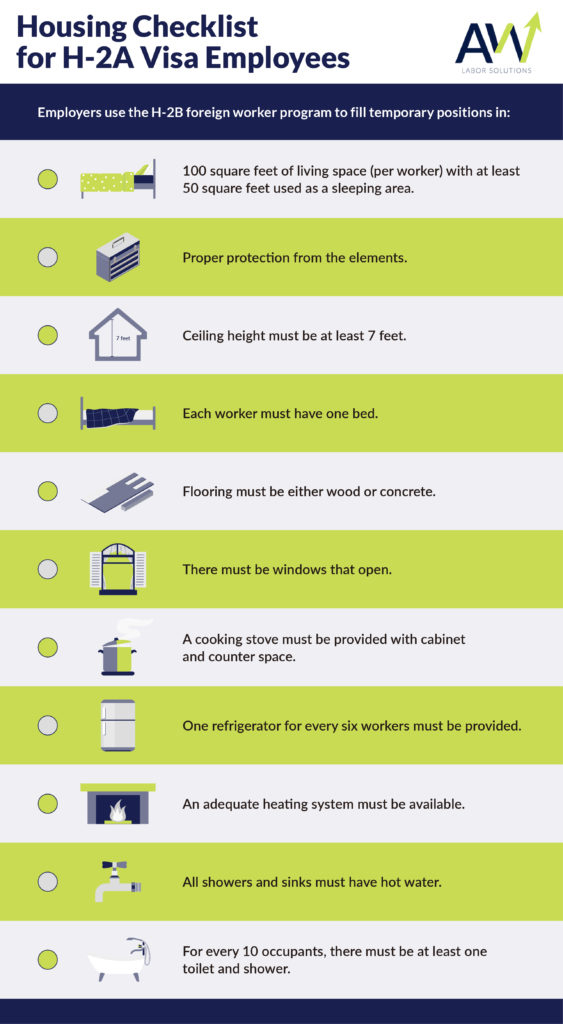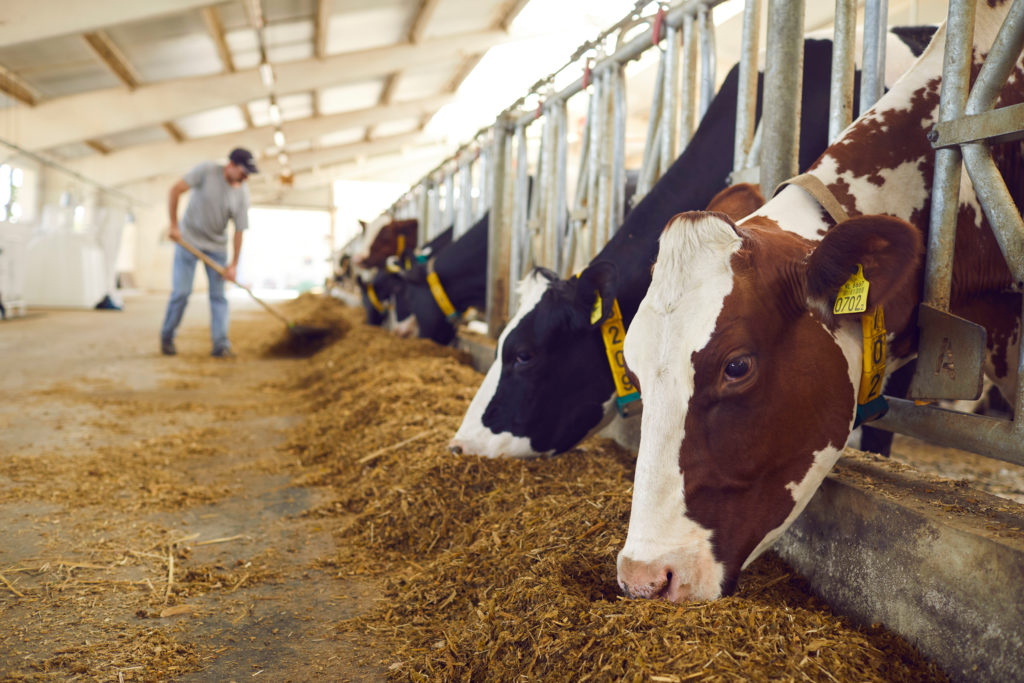
Agricultural business owners seeking seasonal or temporary employees often turn to H-2A workers to fill their needs. However, the program does require that the employer provide the visa holder with housing, transportation, food, and specific wages.
Section 218 of the Immigration and Nationality Act allows nonimmigrant, temporary, foreign workers (H-2A visa workers) to enter the United States to work in seasonal or temporary agricultural positions.
The employer of an H-2A visa holder must provide the following:
Requirements for Employing H-2A Workers
An employer must fill out an application on file with the Department’s Employment and Training Administration (ETA) stating that they have been unable to recruit sufficient U.S. workers who are willing, qualified, able, or available to fill the positions. Employers have to show that they have tried to recruit U.S. workers but have been unable to fill the vacancies so have needed to reach out to foreign workers. They also must take things further by stating that employing foreign workers to fill the position will not impact the wages or working environment of U.S workers serving in similar positions.
The U.S. Department of Labor’s Wage and Hour Division (WHD) oversees the nation’s federal labor laws and enforces compliance by conducting investigations when necessary. The laws encompass all employment in the U.S. and also handle agricultural employment by ensuring that the agricultural employers remain compliant with federal labor law. WHD enforces the law even for H-2A foreign workers. Some states enforce additional or similar labor laws that employers must also comply with.
H-2A Housing Requirements
Employers need to follow a H-2A housing checklist to ensure compliance when hiring foreign workers to meet their seasonal and temporary agricultural needs.

H-2A Housing Regulations
With H-2A housing regulation, employers are required to provide an H-2A worker with no-cost housing if the employer cannot return to their primary residence the same day. If the employer opts to rent accommodations, then they must pay for all housing related charges. The house must be equipped with a kitchen and, if not, then the employer is required to provide three free meals per day for the worker.
Housing Inspections
All residential migrant housing and migrant labor camps are subject to inspection. The inspections must be carried out at a minimum of twice quarterly during occupancy. If a violation is found, then the problem must be promptly reported to the employer and up to 48 hours provided to make proper corrections or take the steps needed to ensure correction. If the housing inspections continually reveal violations, then a fine or citation may occur.

H-2A Minimum Wage
Each year the Department of Labor (DOL) publishes the Adverse Effect Wage Rates (AEWR) which sets the H-2A minimum wage 2021 and H-2A minimum wage 2022. They set the minimum amount that an employer can pay an H-2A worker. However, the H-2A workers’ wages 2022 are forecast to change in the latter part of the year. The DOL has proposed a change to the methodology of the AEWR H-2A program for all of the job descriptions except herding and livestock production. The changes create a steep increase in the wage rate compared to the H-2A workers’ wages 2021.
Employers must pay H-2A workers the highest of the following:
Each year the DOL issues the AEWR using data gathered from the U.S. Department of Agriculture’s (USDA) and the Farm Labor Survey (FLS) that looks at the number of workers, total wages by type and hours worked. The data acts as the reasoning for annual average wage estimates issued for AEWR.
H-2A workers have very precise rights when it comes to wages. The H-2A worker can be paid via piece rate or they can be paid hourly. If they are being paid via piece rate, then they must be paid the prevailing piece rate set forth in the particular geographic area where the work is being performed. The piece rate must be similar to the hourly rates that the worker would receive every two hours.
Hourly pay for an H-2A employee must be the highest of the AEW, the prevailing wage, the agreed upon collective bargaining rate, or federal/state minimum wage.
All AEWR is calculated by the DOL which is tasked with handling the minimum amount H-2A workers must be paid based on the geographic location and occupation. The prevailing wage is determined on surveys of wages that the local employers pay for specific jobs.
H-2A workers must be paid at least twice per month. Employers must compile the worker’s hours and earnings on a statement on or right before the payday.
H-2A Wages 2022

The H-2A minimum wage is as follows.
Agricultural employers must pay their H-2A foreign workers at least the following:
When the AEWR is adjusted higher during a work contract and is higher than the highest of the previous AEWR, employers must pay that adjusted AEWR on and after the effective date, December 29, 2021. Typically, the wage increases work out to about six percent per year. However, the increases due vary depending on state.
In latter half 2022, agricultural employers in:
States with the highest H-2A wages in 2022 include:
H-2A employers in the above states must pay time and half for overtime any time the worker exceeds 40 hours per week.
Agricultural companies in Michigan are one of the nation’s biggest H-2A employers and pay an AEWR of $15.73 but are not required to pay overtime to workers.
Taxing H-2A Workers
An H-2A worker does not have to pay Medicare or Social Security taxes. The employee also does not need to pay such taxes for an H-2A worker which is a considerable savings for the employer.
When filing income tax returns for the year, workers might owe U.S. federal income tax. If the employer and the worker both agree to withhold federal income taxes from the H-2A employee’s paycheck, then the employer is allowed to withhold. A worker must fill out Form W-4 – Employee’s Withholding Allowance Certificate in order for the employer to hold back taxes from the worker’s compensation. Some states do allow employers to withhold a certain portion of the employee’s workers compensation, but the laws do vary by state.
Added Guarantees for H-2A Workers
An H-2A worker is entitled to a three-fourths guarantee. With the three-fourths guarantee, employers must provide H-2A workers with at least 75% (or three fourths) of the workdays as stated in the employment contract.
An example:
H-2A employers must provide all of the required tools needed to carry out the job for the H-2A worker. The employer cannot charge the worker for the tools.
Employers are required to provide worker compensation to all workers free of charge. They must also post a visible poster at the worksite that clearly outlines the rights of the workers concerning workman compensation and all other rights that the H-2A worker has.
An H-2A employer cannot accept payment when it comes to an H-2A labor certification. Employers also cannot hold or confiscate a worker’s visa, passport, or immigration documentation.
Understanding Wages
An H-2A worker is paid for all the time worked each day. The work time does not include commute time from residence or camp to the worksite, or the return from the worksite to the camp or residence. The workday only begins upon arrival at the worksite.
If the H-2A worker has to stop on the way to work to pick up work-related supplies, equipment or material then the time must be reported and paid to the worker for loading or picking up the items.
When working in one field and moving to another field during the workday, the worker must be paid for the travel time it takes to move from field to field.
On occasion, equipment breaks down. If the equipment malfunctions during the workday, then an employer must still pay their H-2A employee during the workday.
During the workday, breaks are required. If a break lasts for only 20 minutes or less, then an employer must pay their employee for the time. Employers must provide a sufficient amount of time to drink water and meet sanitation needs in the field while paying for the time.
An H-2A’s workday ends when the worker finishes working and rides back to their place of residence or camp.

2022 Meal Charge and Reimbursement Rates for H-2A
The 2022 meal charge and reimbursement rates for H-2A foreign workers is $59 per day, but receipts must be provided. If the employee works less than a full day, then the employer has the right to limit the meal expense reimbursement when receipts are provided to 75% of the maximum reimbursement which works out to $44.42. If an H-2A worker fails to provide receipts, then the employer is required to only reimburse the minimum standard of $14 per day.
H-2A Transportation Requirements
Employers must provide or pay for transportation for their H-2A visa workers.
The employer must ensure that the vehicle used for transportation meets all applicable vehicle standards, be operated by a qualified driver who is fully licensed, and ensure that the vehicle has proper insurance. They must carry vehicle liability insurance to protect against damages to persons and property of at least $100,000 per vehicle seat with a maximum of $5,000,000. A van that can carry 11 H-2A workers and the driver must carry a minimum of $1.2 million to remain compliant.
H-2A employers who use a vehicle for worker transport must ensure that the vehicle complies with one of the two standards, which are determined based on the type of vehicle, passenger capacity and distance traveled.
Employers must also ensure that the vehicle is in compliance with state and federal safety standards
H-2A employers are required to follow the DOL standards 29 CFR § 500.105 in the following:
Agriculture businesses often need additional farm labor for harvest, planting, and sometimes even the entire season. Some farm owners use H-2A workers to staff up their operations for the busy seasons.
The H-2A temporary agricultural program establishes a means for agricultural employers who anticipate a shortage of domestic workers to bring non-immigrant foreign workers to the U.S. to perform agricultural labor or services of a temporary or seasonal nature. However, there are many requirements for hiring and employing H-2A workers.
Below are a few considerations concerning housing, wage, transportation, and food for H-2A workers:
Prior to deciding whether to hire an H-2A worker, you’ll want to consider all of the costs and requirements involved in the process. The program can prove highly valuable and cost-effective for agricultural business owners seeking a solution to their seasonal or temporary labor needs. To learn more about the H-2A visa process, contact AW Labor Solutions today.